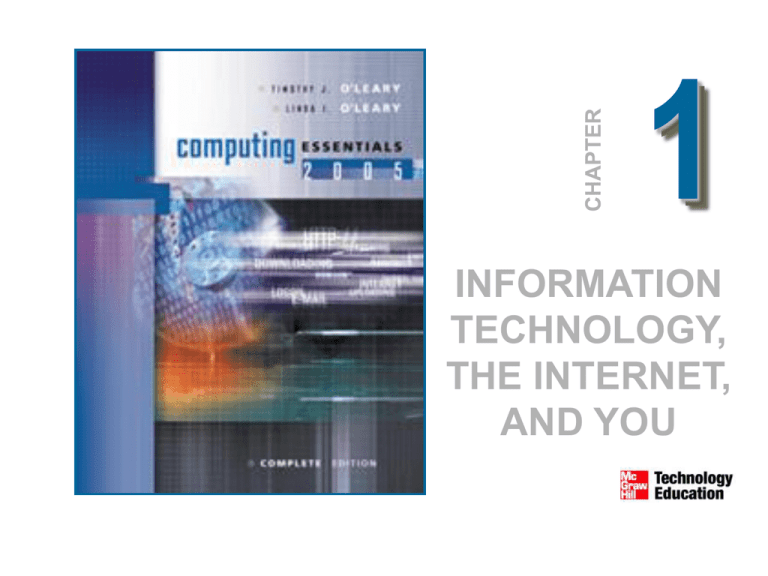
1
INFORMATION
TECHNOLOGY,
THE INTERNET,
AND YOU
1-2
Competencies
Explain the five parts of an information system
Distinguish between application and system
software
Distinguish between special purpose and general
purpose application software
Identify the types of computers and
microcomputers
Describe the different types of hardware
© 2005 The McGraw-Hill Companies, Inc. All Rights Reserved.
1-3
Competencies cont.
Define data and describe files
Explain connectivity and the wireless revolution
Describe the Internet and the Web
© 2005 The McGraw-Hill Companies, Inc. All Rights Reserved.
1-4
Five Parts of an Information
System
1. People
4. Hardware
2. Procedures
5. Data
3. Software
© 2005 The McGraw-Hill Companies, Inc. All Rights Reserved.
1-5
People
Most important part of any system
Contact is …
Direct
Indirect
Computer uses
Business & Entertainment
Education & Medicine
Note : Page 6: Making It Work for You
© 2005 The McGraw-Hill Companies, Inc. All Rights Reserved.
1-6
Software
Programs
Instructions
Two major kinds of software
System Software
Application Software
© 2005 The McGraw-Hill Companies, Inc. All Rights Reserved.
1-7
System Software
A collection of programs
Enables the application software to interact with
the hardware
Background software that helps the computer
manage its own resources
© 2005 The McGraw-Hill Companies, Inc. All Rights Reserved.
1-8
Application Software
“End-user” software
Two major categories
General purpose
Special purpose
© 2005 The McGraw-Hill Companies, Inc. All Rights Reserved.
1-9
Hardware
Equipment that processes the data
Controlled by software
Physical devices
Keyboard
Mouse
Monitor
Other devices
© 2005 The McGraw-Hill Companies, Inc. All Rights Reserved.
1-10
Types of Computers
Supercomputers
Mainframe computers
Minicomputers
Microcomputers
© 2005 The McGraw-Hill Companies, Inc. All Rights Reserved.
1-11
Supercomputers
High capacity
Used by large organizations
Tracking space
Tracking weather
© 2005 The McGraw-Hill Companies, Inc. All Rights Reserved.
1-12
Mainframe Computers
Occupies specially wired, air-conditioned rooms
Capable of great processing speeds and data
storage
Not as powerful as supercomputers
© 2005 The McGraw-Hill Companies, Inc. All Rights Reserved.
1-13
Minicomputers
Known as midrange computers
Medium-size companies
Used by departments of large companies
© 2005 The McGraw-Hill Companies, Inc. All Rights Reserved.
1-14
Microcomputers
Least powerful
Widely used
Four types
Desktop
Notebook or laptop
Tablet PC
Handheld
© 2005 The McGraw-Hill Companies, Inc. All Rights Reserved.
1-15
Microcomputer Hardware
System unit
Input/output devices
Secondary storage
Communications
Display Video
© 2005 The McGraw-Hill Companies, Inc. All Rights Reserved.
1-16
Data
Raw, unprocessed facts
Processing creates information
Stored electronically in files
Document files
Worksheet files
Database files
Presentation files
© 2005 The McGraw-Hill Companies, Inc. All Rights Reserved.
1-17
Connectivity, the Wireless
Revolution, and the Internet
Connectivity
Sharing of information
Wireless communication is becoming popular
Computer networks
Connected communication system of computers
Largest network is the Internet
© 2005 The McGraw-Hill Companies, Inc. All Rights Reserved.
1-18
A Look to the Future
Computer Competent
The Internet & the Web
Powerful software & hardware
Privacy & security
Organizations
Changing Times
© 2005 The McGraw-Hill Companies, Inc. All Rights Reserved.
1-19
Key Terms
application software (9)
basic application (9)
chassis (12)
communication device
(14)
compact disc (CD) (14)
computer competency (3)
computer network (16)
Computing Essentials
CD (8)
connectivity (16)
Data (5)
database file (15)
desktop computer (11)
device driver (9)
digital versatile disk
(DVD) (14)
digital video disc (DVD)
(14)
document file (15)
© 2005 The McGraw-Hill Companies, Inc. All Rights Reserved.
1-20
Key Terms
end user (4)
floppy disk (14)
general-purpose (9)
application
handheld computer (11)
hard disk (14)
hardware (5)
information (4)
information system (4)
information technology
(IT) (5)
input device (12)
Internet (16)
keyboard (12)
laptop computer (11)
mainframe computer (11)
memory ( 12)
microcomputer (11)
© 2005 The McGraw-Hill Companies, Inc. All Rights Reserved.
1-21
Key Terms
microprocessor (12)
midrange computer (11)
minicomputer (11)
modem (14)
monitor (12)
mouse (12)
network (16)
notebook computer (11)
operating system (9)
optical disk ( 14)
output device (12)
palm computer (11)
people (4)
personal digital assistant
(PDA) (11)
presentation file (15)
primary storage (12)
printer (12)
© 2005 The McGraw-Hill Companies, Inc. All Rights Reserved.
1-22
Key Terms
procedures (4)
program (4)
random access memory
(RAM) (12)
secondary storage device
(14)
service program (9)
software (4)
specialized application
(10)
special-purpose
application (10)
supercomputer (11)
SimNet Concepts (8)
system cabinet (12)
system software (9)
system unit (12)
tablet PC (11)
© 2005 The McGraw-Hill Companies, Inc. All Rights Reserved.
1-23
Key Terms
temporary storage (12)
utility (9)
video display screen (12)
Web (16)
wireless revolution (16)
worksheet file (15)
World Wide Web
(WWW) (16)
© 2005 The McGraw-Hill Companies, Inc. All Rights Reserved.
1-24
FAQs
What is an information system?
What is IT?
How does raw data become information?
What is an operating system?
What are specialized applications? Please give
some examples.
Is the Internet the same as the World Wide Web?
© 2005 The McGraw-Hill Companies, Inc. All Rights Reserved.
1-25
Discussion Questions
How are you using information technology?
Explain the difference between system and
application software.
Describe some of the uses for handheld
computers.
Why is the wireless revolution so important?
© 2005 The McGraw-Hill Companies, Inc. All Rights Reserved.





